

Originally posted March 7, 2020
Between the World Wars, a lot of prominent European handgun manufacturers made small blowback automatics chambered in 7.65mm Browning Short (known in the USA as .32 ACP). Unlike similar pistols in the States, which were pretty much exclusively civilian carry guns (apart from a few issued by the US Army to generals), a lot of the European .32s were bought and issued by police agencies and even armies. The one that is probably the most famous of the breed, Germany's Walther PP, was explicitly designed for the job of police sidearm (PP = Polizeipistole).
Here's another one:
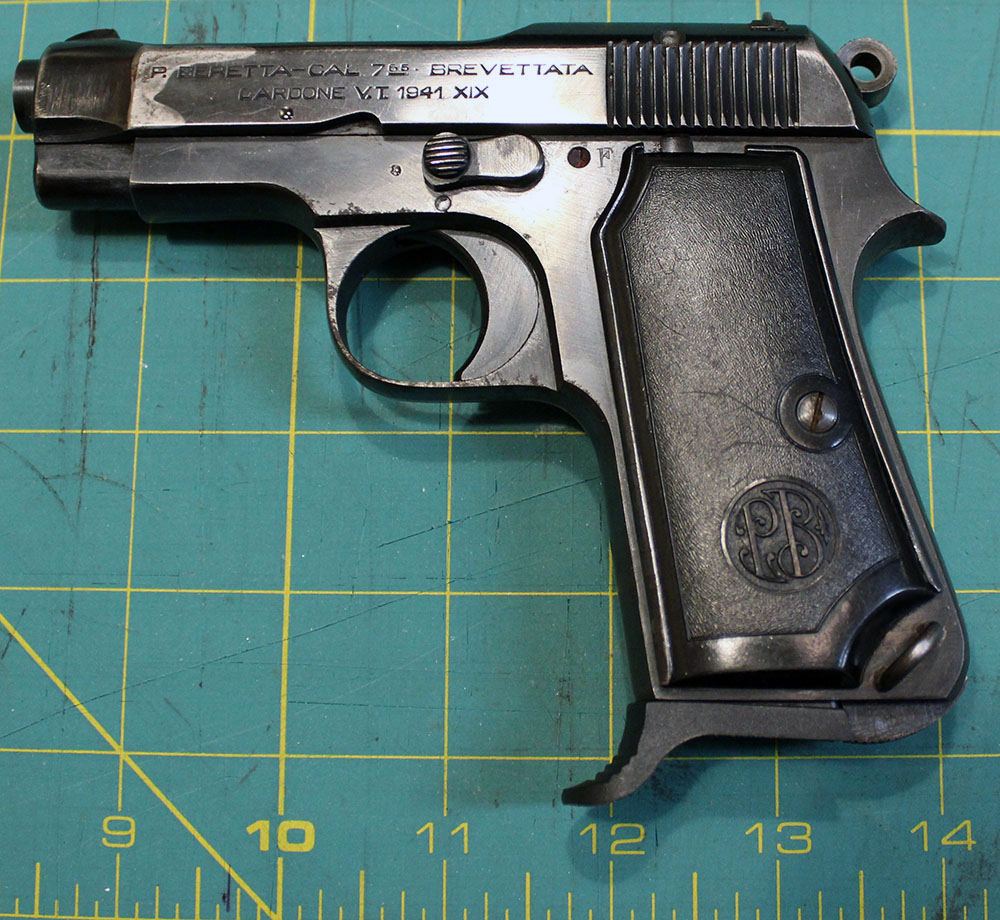
We've discussed Beretta a bit before, so you should be broadly familiar with the company: one of the oldest firearms manufacturers in the world, dating itself to the year 1526 (so I expect their marketing department will be mighty busy here in a few years). In the early part of the twentieth century, they were mainly known for their sporting arms (they're still a big name in shotguns, at least in Europe), but—as with so much else—the Great War changed all that.
As it happens, when the war began, the Beretta factory in Gardone had just recently acquired a new production manager. Tullio Marengoni (1881-1965), an up-and-coming gunsmith/designer and something of a confidante of Pietro Beretta, was 33 when he was put in charge of production, but he was already a twenty-year veteran at the company by then, from which you may gather that he got something of an early start on his career. Rather like the company itself, he made his name with shotguns, but as the war approached he turned his attention to the relatively new field of automatic pistols.
Self-loading pistols had only been a thing for about 20 years at that point, and there were still a lot of them around that couldn't really be considered fully mature designs. One such was the Glisenti Model 1910, which was the standard-issue sidearm of the Royal Italian Army at the outbreak of the war, and which was widely held within said army to be somewhat lacking. It was complicated, hard to maintain, and weak—so weak that, even though it had a locking action, it couldn't chamber anything more potent than the deeply anemic 9mm Glisenti (a cartridge dimensionally identical to 9mm Parabellum but much less powerful, not that that's a recipe for disaster or anything).
Tullio Marengoni figured he could do better, and in the spring of 1915 he created his company's first self-loader (imaginatively named the Beretta Model 1915) specifically to better the Glisenti. The M1915 also used 9mm Glisenti, because that's what the Army had, but it had a much simpler and more robust straight-blowback action and was much easier to use. It was adopted straightaway to replace not only the Glisenti, but also the usual pre-war jumble of antiquated revolvers that the Italian Army, like most of the armies involved in the war, had on hand.
The Model 1915 is important mainly because, in addition to being Beretta's first automatic, it set the basic pattern for all the company's handguns up to and including the Model 92. They may differ mechanically, but all Beretta pistols up to that point share a strong family resemblance, with an open-topped slide, top ejection, and slightly protruding muzzle, and Marengoni's Model 1915 established that aesthetic.
Marengoni went on to develop several variants and evolutions of the M1915, including a version in 7.65×17mmSR Browning Short (.32 ACP) for the Italian Navy, and a mechanically simplified successor, the Model 1923 (which completed the development of the "Beretta aesthetic" by introducing the external hammer mechanism they've gone with ever since). Both models, the M1915 (and variants) and M1923, remained in service until the 1930s, when developments elsewhere in the industry spurred further development.
In 1929, the German gunmaker Walther introduced the PP, a compact semiautomatic pistol aimed (as it were) at the military and police market. Hearing that the Italian Army was eyeing the PP as a possible replacement for the Berettas then in service, Marengoni set about developing a domestic competitor to head off that potential loss of business—and finally get rid of the 9mm Glisenti cartridge while he was at it.
The result was the Model 1934, a more advanced, more elegant, smaller and lighter but more powerful pistol chambering a cartridge the Italians call 9mm Corto, but we here in the States usually call .380 ACP. The following year, Beretta introduced the Model 1935, which was the same gun chambered in .32 ACP. The M1934 was adopted by the Italian Army, while the Navy and Air Force opted for the M1935. The .380 version was also picked up by the Romanian Army.
Beretta produced both models for commercial sale as well, and in something of a turnaround of the original reason for the M1934's creation, many were bought for use by members of the armed forces of Nazi Germany during World War II. After Italy changed sides in 1943, the Germans scooped up all the Berettas they could find during their occupation of the country and issued them out to their own troops. Allied personnel captured them by the sackful in the North African and Italian campaigns. Wherever they were encountered, they were well-regarded as sturdy and reliable handguns, in spite of their use of what would today be regarded as fairly weak cartridges.
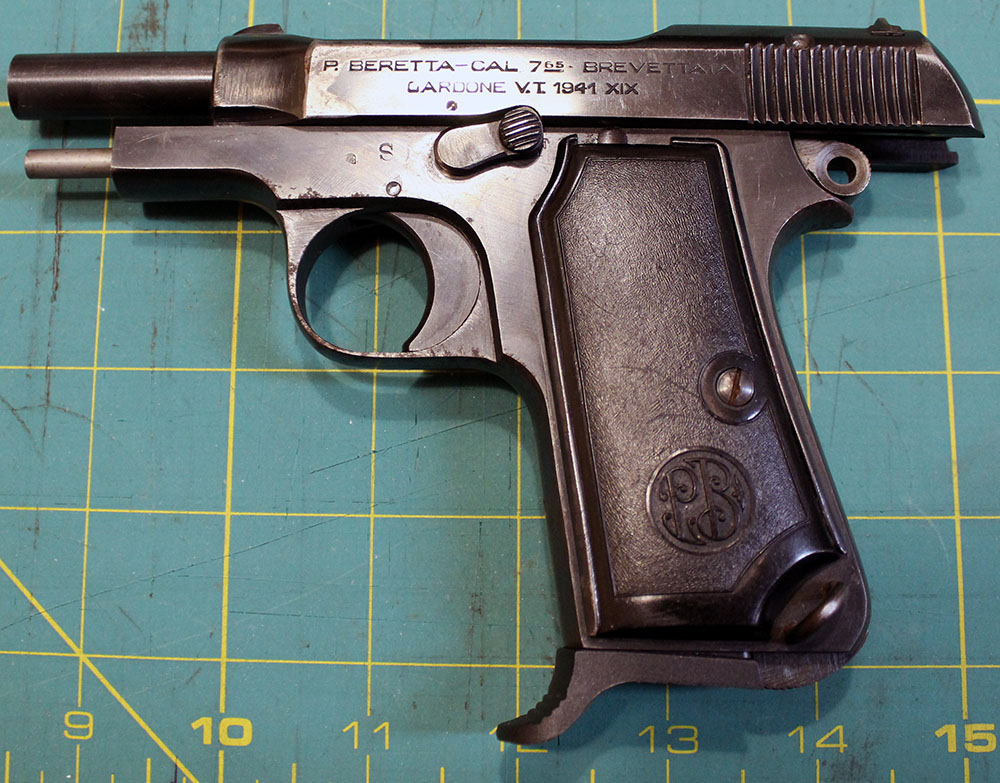
Our specific gun this week is a Model 1935, though, as you may notice, it isn't labeled as such. After P. BERETTA - CAL 7.65 - BREVETTATA (that is, "patented"), its inscription just lists the place of manufacture (GARDONE V.T.), it notes only the year in which this specific pistol was manufactured (or, well, technically proofed, but since that always happened right at the end of manufacture, it works out to pretty much the same thing). In this case, that's 1941; the Roman numeral after the normal date notes that it was also year XIX of the Fascist era (that is, 19 years since Mussolini became prime minister in 1922).¹ Yes, the Fascists were so into themselves that they declared the start of their regime to be a new epoch. You have to give them credit for nerve, if nothing else; not even the Nazis did that.
Note here that the safety lever is also a manual slide lock; with the slide back, it can be pushed up slightly above the usual "safe" position to catch that notch in the side of the slide and hold the pistol open. The gun will also lock open on an empty magazine, but, annoyingly, the slide will drop as soon as the empty is pulled out, so it must be manually locked before this is done to avoid having to cycle it by hand to reload. A lot of early semiautos did this, although it's a bit odd to find a new design that was still doing it in 1934. I guess Marengoni didn't figure speedy reloading was that important in a small-caliber handgun, which would presumably just be a backup to whatever larger weapon the holder had been issued.
Over on the right side, there's pretty much nothing to see, particularly as I was still blurring out serial numbers (in this case, on both the slide and the frame) when I did the photos of this gun. Nowadays I probably wouldn't bother, particularly for one this old, but it got to be a habit. This one is just above 520,000, which seems to line up about right with the 1941 proof date.
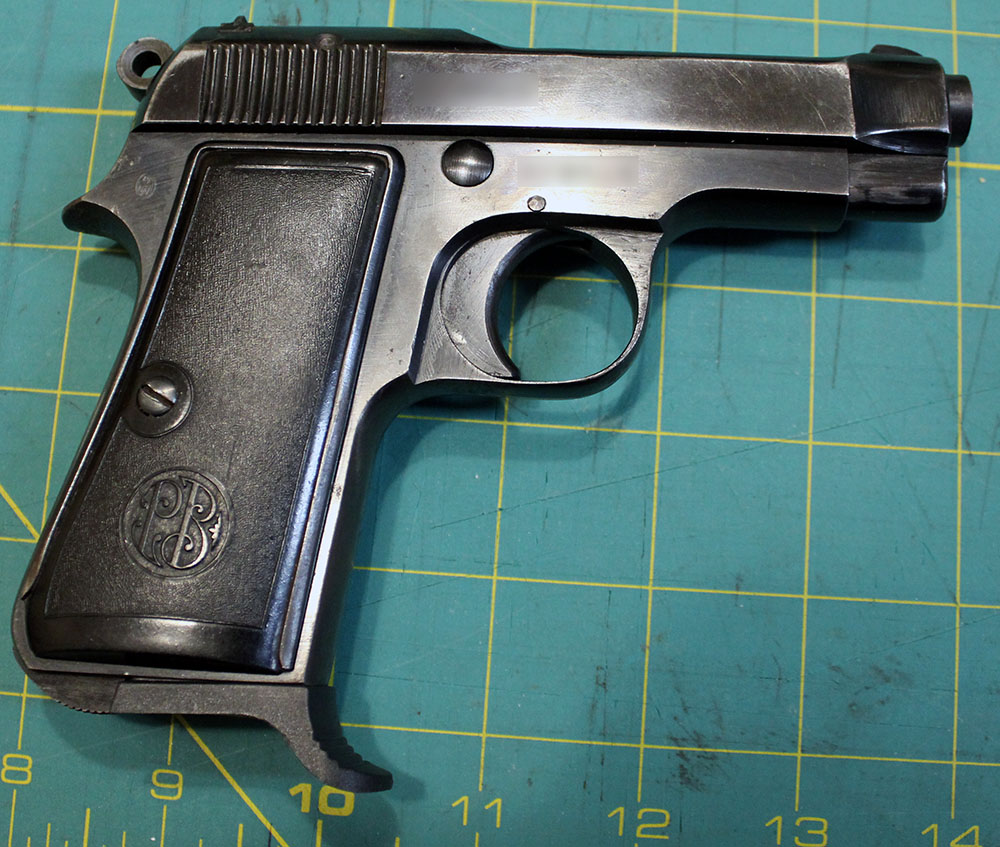
Aside from the serial number, the only marking on this side is that tiny acceptance mark on the tang behind the grip panel:
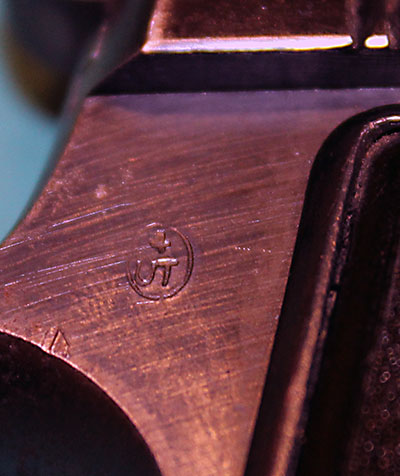
That says "4 UT", which stands for Quattro Ufficio Tecnico di Controllo Armi e Munizioni ("4th Technical Office for Arms and Ammunition Control"), and is a property acceptance mark, which means that this particular pistol passed through that department of the Italian government apparatus. This is where the story, as I've been able to piece it together, gets a little odd. All the sources I've been able to find say that pistols accepted by the 4th Technical Office were destined to be passed on to the German armed forces—but every other one I've seen photos of online has dated to 1944 or 1945, after the fall of the Fascist government.
In itself, this makes sense. When the Allies invaded Sicily in July of 1943, il Duce found himself abruptly ousted from office and placed under arrest. By September, his replacement, Marshal Pietro Badoglio, had negotiated an armistice with—in practical terms, simply surrendered to—the Allies, at which point the German troops rushed into the country to "reinforce" the Italians converted into an occupation force and seized the northern three-fifths or so of the country. At around the same time, Mussolini escaped captivity (with the aid of a German raiding force that included our old friend Otto Skorzeny, no less) and fled to Bavaria.
Shortly thereafter, and for reasons no one can really be sure of, Hitler propped his old pal Benito back up as the leader of the so-called "Italian Social Republic", a puppet state claiming jurisdiction over all of Italy, but in actual fact simply a neo-Fascist rubber mask hung on the Wehrmacht occupation zone. This lasted until May 2, 1945, when the German forces remaining in Italy surrendered, two days after Hitler's death and four since Mussolini himself had been captured and summarily executed by pro-Allied (or at least anti-Fascist) partisans.
The point of all this is that Gardone was within the Italian Social Republic, and so Beretta kept making weapons for the Germans until more or less the end of the war. This is why it makes sense that all of the "4 UT" Beretta 1934s and 1935s I've seen photos of date from that period—the factory's production would have been going nowhere but to the Germans, and thus through the Fourth Technical Office, during that time.
The mildly puzzling thing is that I haven't found any other evidence, besides my own gun, that the Fourth Technical Office was a thing before the Italian Social Republic period. Generally Berettas adopted into German service before then sport Waffenamt acceptance marks from whichever branch of the Wehrmacht issued them, or else, if they were purchased individually by their German owners, they have the stamp of a German civilian firearms importer, Günter Genschow & Co. (GECO).
I'm sure this is just an artifact of incomplete data, and not some sort of shenanigan. If someone had tried to fake a German property mark in order to make this particular pistol more valuable, they'd have stuck a Waffenamt stamp on it, because, not to put too fine a point on it, when it comes to WWII-vintage guns, swastikas sell. Sticking a fake Fourth Technical Office stamp on it would be too subtle for that kind of fraudster to attempt. Still, it's interesting. It suggests that this gun went to someone in the German apparatus somewhere—and quite early on, unless it sat in inventory for a while after being completed and proofed, which seems unlikely given the popularity of these pistols—but is silent as to any further details.
Unfortunately, the only company-supported serial number lookup I could find for Berettas is run by Beretta USA, so it only covers guns that were either manufactured in the United States, or imported from the factory and originally sold by the company's American subsidiary. Since this one lacks import markings of any kind, I assume it was a bring-back from the war (one of a great many, since these were particularly prized, well, prizes at the time).
Anyway, with that historical digression over, let's have a look at how it works. Disassembly on these is a little bit of a change of pace from the usual Walther PP-style setup we've seen on so many other small European pistols of the WWII-to-Cold War period, and unfortunately it doesn't lend itself to in-progress still photos, so I'm just going to have to describe it. What you have to do (after removing the magazine and making sure the chamber is empty, of course) is lock the slide open using the safety, as shown above, and then—I'm not kidding—get a small hammer made out of something softer than steel (nylon or leather, preferably) and tap on the muzzle until you dislodge the barrel from its locking lugs on the frame. Once it's free, you can tip the back end of it up and pull it out through the open top of the slide, after which disengaging the safety-slash-slide lock enables the slide and the main spring to come off the front in a reasonably conventional manner. Once it's all apart, it looks like this.
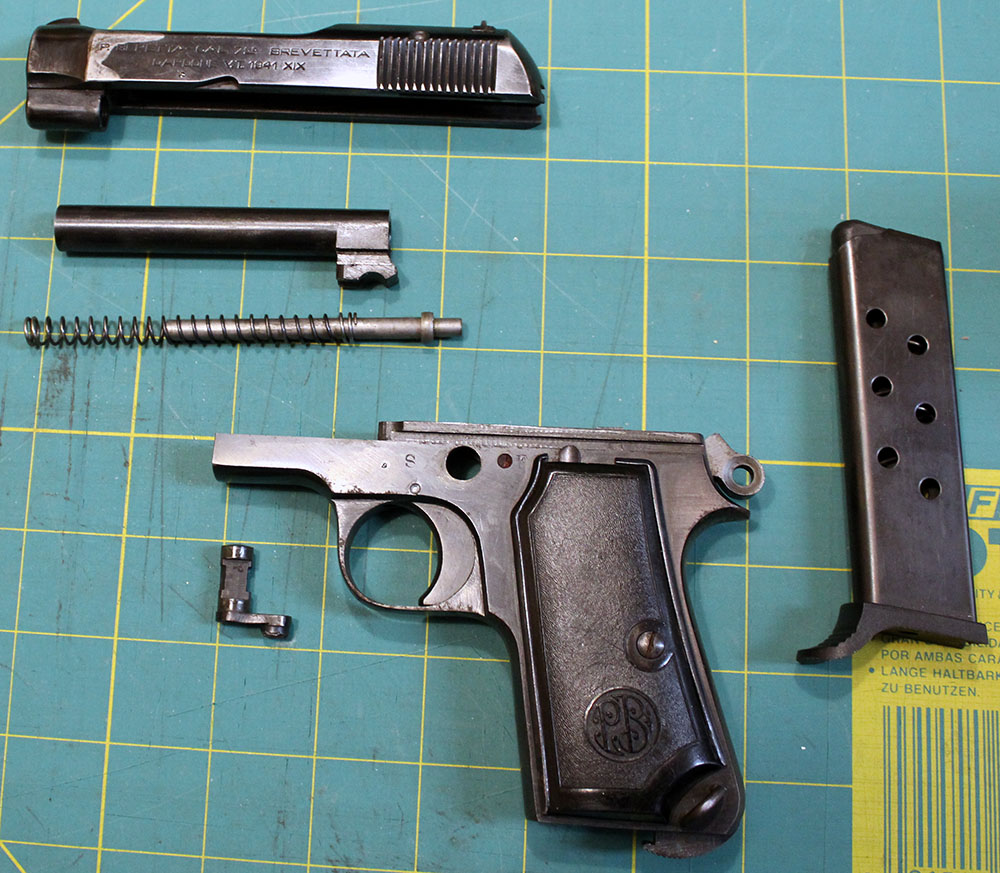
You can see the lugs on the bottom of the barrel; they mate with a set inside the frame. See the semicircular cutout in the bottom of the block at the rear end of the barrel? That corresponds to the hole for the pin on the safety. That, in turn, has a flat milled on it (you can see it just below the front of the frame, above), so that the barrel can only be removed if the lever is in the "safe" position; when it's in "fire" the round side is up in that cutout and ensures that the barrel can't move. (It's in there pretty tight anyway.)
The recoil spring and its guide rod fit into a round pocket in the front of the frame, just below and in front of the barrel locking block, and the other end fits into the front of the slide below the muzzle, not entirely unlike the way it works in a Colt Pocket Hammerless. Getting those lined up again is the only really fiddly part about putting a Beretta 1934 or 1935 back together. Once they're aligned and the slide is locked all the way back again, you can drop the barrel back into the open-top slide, then finagle it forward until it starts to engage with its locking grooves. It fits too tightly to be pushed back to its final position by hand, so the procedure is to drop the slide on it a couple of times—effectively using the breechface to hammer it back into place.
As with most .32 ACP pistols, the action itself is a simple blowback system, with no locking mechanism. The gun is hammer-fired, with a single-action trigger. In addition to its duties as the disassembly pin, the safety blocks the trigger from operating. And, mechanically, that's pretty much all there is to it. The sights are as basic as you would expect from a small auto pistol designed in the 1930s, although they are fairly tall and easy to read.
Apart from being unusually heavy for its size (possibly because it was originally developed as a .380), the M1935's only real operational drawback is its magazine catch.
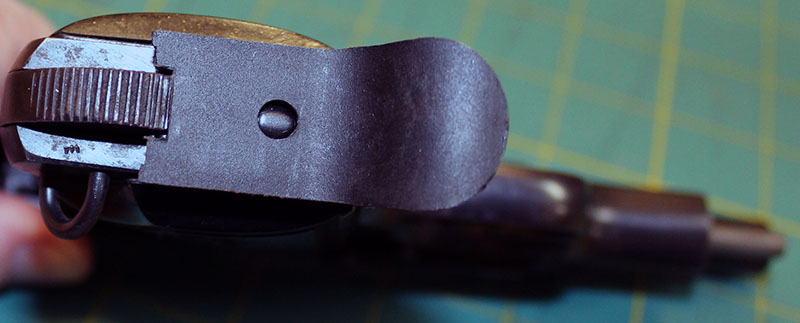
Like most European pistols of its era, it has a heel release, which some people like better than others, but what the photo doesn't really capture is that the Beretta's is extremely stiff and hard to operate. Its spring weight also makes it hard to get a magazine into the gun, as you have to lever the catch out of the way with the magazine body the whole time you're sliding it in. This is not a gun that makes for quick or easy reloads in an emergency, or at any other time.
Speaking of magazines, another oddity about this particular Beretta doesn't really have anything to do with the gun itself, but rather the magazine it came with. The one you see in the photos above is one I tracked down and bought after the fact, which is why it looks newer than the gun. The magazine that it came with is on the left in the picture below.
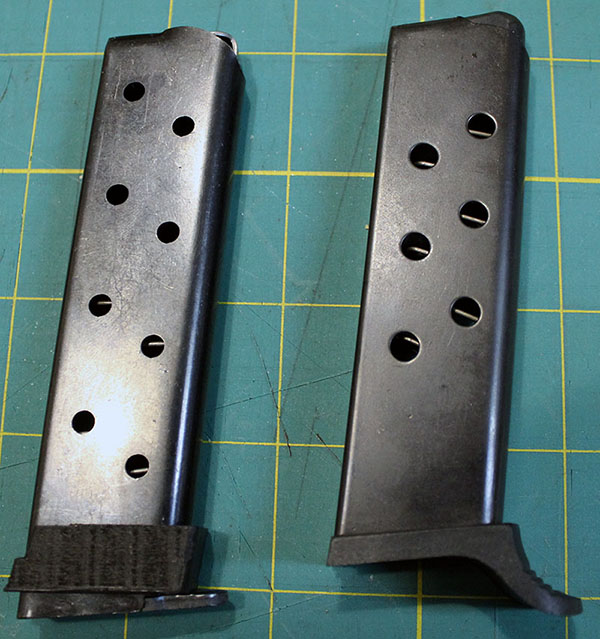
As you can see, that is not a Beretta M1935 magazine. I don't know what it's originally from—it looks like a Colt 1903 magazine, but it isn't; it fits into the magazine well of mine all right, but it's too long to lock and the feed angle is different. Whatever it's from, someone modified it to fit this Beretta.

Whoever did this cut a slot in the back for the magazine catch—normally, as you can see above, it just catches on a notch at the heel of the magazine—and made that spacer collar to slide on and prevent the magazine from being overinserted. The thing I find most interesting about this is that, unless I'm very much mistaken, that part was made on a commercial 3D printer, so presumably just within the last 10 years or so. Of course, we can't know whether it's a replacement for an earlier part, or that dates the whole modification, but either way, it suggests that someone with some ingenuity owned this gun before me—possibly immediately before me.
And there you have it! Apart from the magazine catch, which is maddening, this is a nice little gun. I can see why they became such sought-after collectibles after the war, and why Beretta was able to keep it in production into the late 1960s.
As for Tullio Marengoni, he had a very long career, and absolutely all of it was at Beretta. He designed pretty much all of their handguns between 1914 and 1957 (and established the pattern that we still see today in the 92/96 family and the Taurus PT92), as well as their highly-regarded sporting shotguns. (He also designed the Beretta Model 38 submachine gun, which no less an authority than Ian McCollum of Forgotten Weapons rates as one of the best SMGs of World War II.) Marengoni was so devoted to Beretta that he actually lived on the factory grounds from the age of 24 until he retired at 76, and even then he kept coming to work until his death in 1965, aged 84.
¹ Annoyingly, the start date of the Fascist Era was October 22 (the date of Mussolini's accession), which means that the Fascist years and the Gregorian ones don't line up. Because of this, even the Fascists themselves still had to stick Gregorian dates on everything in order for anyone to know when it actually happened.